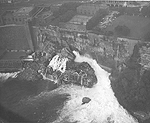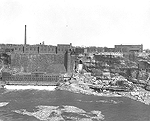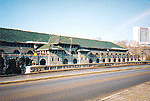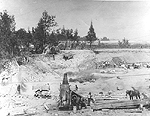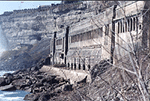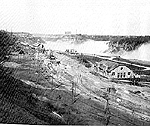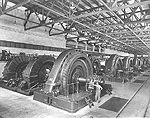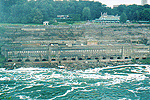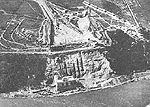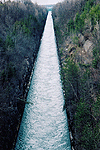Niagara Falls History of Power (original) (raw)
NIAGARA FALLS
HISTORY of POWER
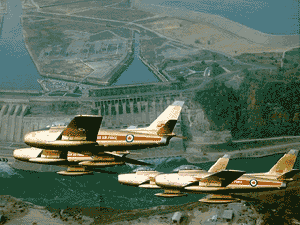
Sir Adam Beck Hydro Generating Stations with the Canadian Golden Hawks F86 Sabre Jets flying overhead circa 1960
Since 1759, the forces of the Niagara River have been harnessed in some manner for the advantage and advancement of mankind. Follow the history of these milestones in the development of hydro-electric generation over the last 250 years to the present time. Find out how power is produced and how it is distributed. What does the future hold for further development at Niagara Falls?
Current Power Generation at Niagara
| Generating Station Name | Number of Generators | Output Capacity |
|---|---|---|
| USA | ||
| Robert Moses GS | 13 Generators | 2,400,000 Kilowatts |
| Lewiston Pump GS - Reservoir | 12 Reversible pump-generators | 300,000 Kilowatts |
| Total Power Generation Capacity | 2,700,000 Kilowatts | |
| CANADA | ||
| Sir Adam Beck #1 GS | 10 Generators | 498,000 Kilowatts |
| Sir Adam Beck #2 GS | 16 Generators | 1,499,000 Kilowatts |
| Sir Adam Beck Pump GS - Reservoir | 6 Reversible Pump Generators | 174,000 Kilowatts |
| DeCew #1 GS - St. Catharines | 5 Generators | 23,000 Kilowatts |
| DeCew #2 GS - St. Catharines | 2 Generators | 144,000 Kilowatts |
| Total Power Generation Capacity | 2,338,000 Kilowatts | |
| Fortis - Rankine GS - RETIRED 2009 | 11 Generators | 75,000 Kilowatts |
Robert Moses Generating Station - water diversion capacity is 109,000 cubic feet per second
Adam Beck #1 � (one unit produce 25 cycle) - water diversion capacity is 22,000 cubic feet per second
Sir Adam Beck #2 � water diversion capacity is 42,400 cubic feet per second
Rankine Generating Station - (produces 25 cycle power) this power station has been retired from service
INDEX
Thomas Evershed & the Hydraulic Tunnels
Edward Dean Adams & the Niagara Falls Power Company
In Search of Long Distance Transmission
Niagara Falls Powerhouse #1 & #2
The Schoellkopf Power Plant Disaster
Queen Victoria Parks Commission
The Niagara Falls Park & River Railway Power Station
Canadian Niagara Power Company
Toronto Electric Light Company & The Toronto Power Station
Sir Adam Beck - Niagara Generating Station #1
Sir Adam Beck - Niagara Generating Station #2
Robert Moses Niagara Generating Station
Niagara River Water Diversion Treaty
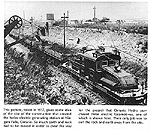 Building the Hydro Canal - Sir Adam Beck #1
Building the Hydro Canal - Sir Adam Beck #1
Origins of Power
In 1759, Daniel Joncairs was the first recorded person to have harnessed a very small portion of the power of Niagara. He dug a narrow ditch above the falls on the American side and was able to draw enough water from the river to turn a waterwheel to power a small sawmill. Joncairs did not invent the waterwheel, however before he arrived, the power of Niagara was being used for nothing more than washing.
Augustus & Peter Porter
In 1805, Augustus & Peter Porter of Buffalo, New York came to Niagara Falls. Both were advocates of the War of 1812. The Porter brothers purchased the American Falls from the State of New York at a public auction. With this purchase, they acquired the water rights to the eastern rapids above and below the falls as well. The Porter's built a water powered gristmill and tannery along Joncairs' old ditch. The Porter's were forced out of business when the Erie Canal opened twenty years later.
The Porter brothers held on to the American Falls and their water rights. Augustus' initial plan was to use the power generated in the 50 foot (15m) drop of the rapids above the falls but he could find no interested financiers. Augustus Porter dreamed of bigger and better things. He envisioned bypassing the falls with a hydraulic canal leading to a large reservoir on the cliff above the gorge. From here the water would flow to the base of the gorge to turbines connected by belts to industrial machinery above.
Augustus and Peter Porter both died before construction of this canal had began. A series of companies that followed also went bankrupt while attempting to build this canal.
In 1853, the Niagara Falls Hydraulic Power & Manufacturing Company was first chartered. The Niagara Falls Hydraulic Power & Manufacturing Company had purchased the water rights and began construction of this canal. In 1860, construction of the hydraulic canal began. The canal was 35 feet (11m) wide and 8 feet (2.4m) deep. It transported water from the Niagara River above the Falls to the mill sites below the Falls. The canal construction was completed in 1861. Augustus Porter's vision became reality in 1875, when the first wheels began turning in the new powerhouse.
After the death of Augustus Porter, entrepreneur Horace Day took over and for the next seventeen years worked sporadically on the canal. He had only one customer, Charles Gaskill's flour mill. By 1877, Day had completed one mile of the canal and was bankrupt.
By 1881, the power company had built a small generating station and began providing a small amount of electricity to light the village of Niagara Falls and to provide power to several of the mills. This power plant became a tourist attraction. It operated a flour mill for two years before the company went bankrupt and all its assets were sold at public auction.
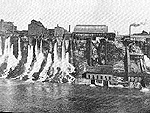 an historic photograph of the mill district in
Niagara Falls New York in 1880
an historic photograph of the mill district in
Niagara Falls New York in 1880
courtesy of the Niagara Falls (Ontario) Public Library
On September 4, 1882, the first coal fed commercial power station, located on Pearl Street in lower Manhattan, went into operation providing light and electricity power to customers in a one square mile area; the electric age had begun. Thomas Edison's Pearl Street electricity generating station introduced four key elements of a modern electric utility system. It featured reliable central generation, efficient distribution, a successful end use (in 1882, the light bulb), and a competitive price. A model of efficiency for its time, Pearl Street used one-third the fuel of its predecessors, burning about 10 pounds of coal per kilowatt hour, a "heat rate" equivalent of about 138,000 Btu per kilowatt hour. Initially the Pearl Street utility served 59 customers for about 24 cents per kilowatt hour. In the late 1880s, power demand for electric motors brought the industry from mainly night time lighting to 24-hour service and dramatically raised electricity demand for transportation and industry needs. By the end of the 1880s, small central stations dotted many U.S. cities; each was limited to a few blocks area because of transmission inefficiencies of direct current (dc).
Jacob Schoellkopf
Jacob Friedrich Schoellkopf was born in 1819. He and his family owned and operated a prominent tannery business in Kirchheim, Unterteck. He was the youngest of seven daughters and three sons. Early in his career, Joseph Schoellkopf came to Buffalo, New York with $800 and started a tannery business.
In 1848, Schoellkopf married Christina Duer. They had six sons and one daughter.
Schoellkopf was a very successful businessman. He owned multiple tanneries in Niagara, Milwaukee and Chicago. He was also very successful in the business of milling flour.
On May 1st 1877, Jacob Schoellkopf purchased the hydraulic canal land and water and power rights for $71,000. When Schoellkopf had taken control of the hydraulic canal, power was transmitted by a combination of belts and drive shafts. Electricity was still in its infancy and used only for telegraphy and the newly invented telephone.
Schoellkopf improved the hydraulic power canal and organized the fourth Canal Company.
In 1879, Schoellkopf started the Schoellkopf Chemical and Dye Company for his two son's: Jacob and Hugo.
Schoellkopf found new customers for his powerhouse. Soon water was flowing over the edge of the gorge to the turbines below, a sight that was as spectacular as the Falls themselves. Schoellkopf realized the future in harnessing the power of Niagara was in the commercial production of electricity. He adapted this available electrical technology to his powerhouse turbines and one of the first hydro-electric generating stations in the world was born.
Illumination of Niagara Falls had been an attraction since 1860. Calcium flares were used originally to light the area however they were expensive and did not last long.
In 1881, Charles Brush of Euclid, Ohio arrived in Niagara Falls with 16 electric carbon arc lights and a generator to illuminate the Falls. Schoellkopf offered the power from his water turbines to power Brush's generator. This marked a milestone in the history of the illumination of Niagara Falls.
By 1882, Schoellkopf had built a small power house at the end of the canal and installed a small generator . It was one of the first generators to be built by the Bush Electric Light Company. Bush had recently demonstrated his successful arc light. The small generator lighted sixteen lights in the streets of Niagara Falls, New York. The Bush generator produced direct current which could not be transmitted more than 1-2 miles.
By 1882, Schoellkopf had attracted seven mills along the high bank (the top edge of the Niagara Gorge north of the American Falls) all producing power from the hydraulic canal.
Jacob Schoellkopf Sr. died in 1903. His sons took over the operation of the power business.
In 1904, a second power station was built boosting power output to 34,000 horsepower.
In 1918, Schoellkopf's Hydraulic Power Company merged with the Niagara Falls Power Company owned by Edward Dean Adams. The Niagara Falls Power Company name was retained.
Thomas Evershed & the Hydraulic Tunnels

a historic photograph of the Mill District in _Niagara Falls New York in 1886_courtesy of the Niagara Falls (Ontario) Public Library
In 1886, Thomas Evershed, a New York State engineer submitted a plan for the generation of 200,000 horsepower at Niagara Falls. Evershed's plan called for the utilization of the entire water fall from the upper Niagara River to the lower Niagara River (below the Falls). A series of canals would serve hundreds of mills above the Falls while a huge runoff tunnel would extend under the Town of Niagara and empty into the lower Niagara River near the Clifton Suspension Bridge.
The direct current of electricity that was being utilized could not be transmitted more than two miles. It could not be transmitted to the nearest population center in Buffalo, New York. Many world famous experts saw the far reaching hydro-electric power generating potential at Niagara Falls.
New York State had reacquired the ownership of the American Falls and was in the process of establishing a large park near the Falls.
Engineer Thomas Evershed proposed to bore a wide ice proof tunnel 2.5 miles (4 kms) under Niagara Falls, New York to feed 38 vertical shafts containing turbines which would feed power to factories above.
A group of businessmen formed a group called the Niagara River Hydraulic Tunnel Power & Sewer Company and secured a charter in 1886 to divert water from the upper Niagara River just outside of the Niagara Reservation State Park, but could not attract enough money to finance this project.
Between 1886 and 1890, construction was stalled. Evershed's mill-over-wheel plan was deemed too inefficient and costly. No suitable way to transmit the power had been developed and a decision as to what type of motor that would be used in power generation had not yet been made.
Engineers altered Evershed's plan to distribute power from a central station.
Edward Dean Adams & Niagara Falls Power Company
In 1899, the company was re-organized and became the Niagara Falls Power Company. This company adopted Evershed's idea but by the time power was finally harnessed, Evershed's scheme had changed considerably.
Edward Dean Adams, a New York financier became the president of the Niagara Falls Power Company.
The Niagara Falls area could not use all the power that would be generated and there was still no method to deliver electricity long distances.
Most American built engines had a maximum capacity of 100 horsepower. The Niagara Falls Power Company planned to use 200,000 horsepower but this leap in technology requires financial resources beyond that available.
In 1889, a company subsidiary, the Cataract Construction Corporation was incorporated. Financiers included J.P. Morgan, John Astor, William Vanderbilt and Edward Dean Adams.
With the financial support, the Cataract Construction Corporation built a shortened version of the power tunnel before deciding on the a method of power distribution. They acquired a 1,500 acre tract of land above the Reservation State Park for industrial tenants.
In Search of Long Distance Hydro-Electric Transmission
The Niagara Falls Power Company offered a $100,000 prize for anyone who could develop a method to transmit electricity long distance. No one responded to this offer. A world wide search began. A think tank of the worlds most brightest minds met in London, England.
Younger geniuses favoured alternating current while the elders favored direct current.
Against the advice of Thomas Edison and William Kelvin, alternating electrical current was selected as the standard to be used.
Nikola Tesla was born in Smiljan, Croatia in 1856.
Tesla created an effective alternating current (AC) transmission system that would be adapted worldwide. George Westinghouse, a American inventor and manufacturer began development of Tesla's system.
In 1883, Westinghouse created an illumination system for Niagara Falls using AC current.
On May 6th 1893, the Cataract Construction Company decided to use alternating current (AC) for power generation and transmission.
Niagara Falls Power Company Powerhouse #1 & #2
(Adams Powerhouse)
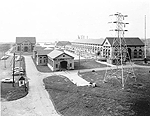
a historic photograph of the Adams Power Station Niagara Falls New York
courtesy of American Memories Collection
From 1892 to 1894, the Niagara Falls Power Company built a 6,700 foot (2042m) long, 21 foot (6m) high and 18 foot (5m) wide horseshoe shaped tunnel which was 160 feet (49m) underground. Twenty-eight workers died in construction related accidents during this project. The tunnel extended from the Niagara Power Company Powerhouse. The tunnel displaced 300,000 tons of rock and required 20 million bricks and 2.5 million feet of lumber to line and shore the interior.
Edward Dean Adams would design the requirements for the Niagara Falls Power Company Powerhouse #1. The new powerhouse was built 1.5 miles above the Falls.
Powerhouse #1 was built in bayed sections highlighted by circular topped windows measuring 14 feet wide and 15 feet high. The building was originally 140 feet long however it was expanded to 450 feet long when all of its generators were installed. Water delivered to the pit wheels below the powerhouse would deliver 100,000 horsepower.
The Niagara Falls Power Company Powerhouse #2 was build between 1901 and 1903.
In 1895, the Niagara Falls Power Company began placing contracts with the Westinghouse Company for long distance electric transmission development and implementation. It included the building of transformers that could handle 1,250 horsepower and the stringing of overhead wires capable of transmitting 11,000 volts.
On November 15th 1896, the City of Buffalo joined the power grid being generated from Niagara Falls. It became the first long distance transmission of electricity for commercial purposes. With this new success, new industry moved into the area.
Mr. Edward Lanphere studied electricity and back when the first turbines for the generation of electricity were being installed at Niagara Falls, he was there and not only helped install the equipment In the first units but was allowed to pull the switch which let the power flow into the lines sending current to the city of Buffalo at the age of 34. Edward was born on July 5th 1862 in the village of Arkport.
The Schoellkopf Power Plant Disaster
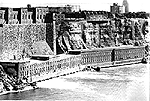 A view of the Schoellkopf Power Plant before the 1956 disaster
A view of the Schoellkopf Power Plant before the 1956 disaster
courtesy of the Niagara Falls (Ontario) Public Library
In 1895, Schoellkopf built his second power plant directly in front of the original plant. The sides of the gorge were walled in. Behind the walls shafts carried water down the 210 feet (64m) to the turbines located just above the water level. Behind these shafts and rear walls of the new plant were old cuts in the rock face which were used during the era of the belt and shaft drive technology. Over the years, water seeping behind the wall had undermined the rock face of the gorge behind the plant.
A view of the Schoellkopf Power Plant following the collapse
courtesy of the Niagara Falls (Ontario) Public Library
On the morning of June 7th 1956, workers noticed water seeping into the plant from the back wall. By mid afternoon, the cracks in the rear wall were widening while 40 men worked with sandbags to stem the flow of water.
Suddenly a loud rumble was heard from behind the wall and the wall began to collapse. One of the workers died. The rest escaped unscathed. The entire southern portion of the plant collapsed into the river below. As the generators blew apart, some debris was propelled to the Canadian side of the gorge. During the fifty years of its existence, the Schoellkopf Power Plant had become outdated long before its collapse.
Read more about theSchoellkopf Power Station Disaster.
the Schoellkopf Power Plant after the 1956 collapse
courtesy of the Niagara Falls (Ontario) Public Library
The Queen Victoria Parks Commission
In 1885, the Ontario Government legislated that all the land along the shore of the Niagara River between Lake Erie and Lake Ontario be designated as parkland. This designation delayed hydro-electric development along the Canadian shoreline. The Queen Victoria Niagara Falls Parks Commission was established. Creating and preserving this parkland was much more expensive than anticipated. Soon the Niagara Parks Commission was looking for ways to generate a greater cash flow. The Commission began leasing the power of the Canadian Falls to American companies.
The Niagara Falls Park & River Railway
Power Station
The first electricity generated in Queen Victoria Park was at the Niagara Falls & River Railway Power House. It was a 2,100 horsepower plant located just above the Table Rock site. It was built by an American company which owned the Niagara Falls Park & River Railway and was used to power its electrical trains between Queenston and Chippawa.
The powerhouse was built in 1892 just above the Horseshoe Falls and provided direct electrical current (DC) for the railway. The water intake was shared with the City of Niagara Falls waterworks.
The powerhouse contained three 1000 horsepower reduction turbines operating at 200 revolutions per minute. The turbines were built by W. Kennedy & Sons of Owen Sound, Ontario.
In 1904, three additional turbines were added.
The Niagara Falls Park & River Railway ceased operations in 1932.
The tailrace tunnel was 600 feet long cut just below the Lockport Limestone layer of rock
Two American companies joined by one Canadian company were given licenses to generate a total of 400,000 horsepower. The first large plant was not completed until 1905. Power generated was transmitted to locations within the U.S.A. Niagara Falls continued to generate electricity by steam until 1912.
Canadian Niagara Power Company
A view of the Canadian Niagara Power Generating Station located above the Horseshoe Falls
The Canadian Niagara Power Company was incorporated in 1892. This American based company under the leadership of William Birch Rankine built a hydro-electric generating plant which was located approximately 500 yards above the Horseshoe Falls. This hydro-electric power station was inaugurated as the William Birch Rankine Power Station. It started generating electricity on January 1st 1905.
Principal investors in this power project included the Rothchilds, J. P. Morgan, and John Jacob Astor IV.
The Rankine Power Station was opened with two 10,000 electrical horsepower generators.
A sideview of the Canadian Niagara Power Generating Station
The power house is built on what used to be Cedar Island. It takes advantage of the normal river current which used to flow around Cedar Island. A submerged weir diverts water into the forebay. The water enters the power house through steel penstocks which lead to the turbines located near the bottom of the wheel pit, 130 feet (40m) under ground. After the water passes through the turbines it is discharged through a 200 foot (60m) long tunnel to the river below.
In 1907, the Rankine Power Station provided the first electricity to the Village of Fort Erie.
By 1927, construction of the Rankine Power Station was completed. The final cost of construction of this power station including the installation of its eleven generators cost $5,199,827.78.
Until 2007, Canadian Niagara Power continued to provide power to approximately 14,000 Fort Erie households, businesses and industries. Bulk power supplies are distributed throughout Ontario and New York State.
A view of the generators at the Canadian Niagara Power Generating Station
Eleven generators produced 100,000 horsepower (75 megawatts). The generators have vertical shafts, wound for three-phase current, produced 11,000 volts of 25 cycle power at 250 revolutions per minute.
This generating station was retired from active service in 2009. This plant went into operation January 1st 1905 and continued to operate as part of the Niagara Mohawk and Fortis Incorporated Power Group.
The Canadian Niagara Power Company was the only Niagara Falls power company to remain privately owned. It was initially affiliated to the Niagara Falls Power Company. In 1950, it became a subsidiary of the Niagara Mohawk Power Corporation.
On September 5th 2000, National Grid Group (United Kingdon) and Niagara Mohawk signed an agreement to merge. Under this agreement, National Grid will acquire Niagara Mohawk through the formation of a new National Grid holding company, New National Grid.
_An historic view of the construction of the forebay of the Canadian Niagara Power Generating Station_courtesy of the Niagara Falls (Ontario) Public Library
In 2000, the Fortis Incorporated Power Group purchased this hydro-electric power generating station. It is the last of the low head power stations remaining at Niagara Falls. The former Toronto Power Station (Electrical Development Company) and the Ontario Power Company have since been retired.
Since 2001, based upon an agreement between the Fortis Group and Ontario Power Generation, the Rankine Power Station has not been producing any power. The 25 cycle power that had been produced at the Rankine Station is now being produced at the Sir Adam Beck Hydro-Electric Power Generating Station #1 in a more economical manner. As part of this agreement Ontario Power Generation was paying the Fortis Group for the amount of power that the Rankine Station would normally have produced.
Until 2009, the Rankine Station sat in a quiet vigil with a much reduced staff that ensures that this station is being mechanically maintained and can be called upon at a moments notice to begin producing power if required in the case of an emergency. In a bit of irony, the Rankine Station receives electrical power from the Sir Adam Beck Power Station to maintain its state of readiness.
The future of the stately Rankine Power Station as a functioning power station is now questionable. The cost to retro-fit this power station from 25 cycle to 60 cycle power will in all likelihood be too expensive to be cost effective in order to compete with the much larger and more efficient power plants down river. It appears that its water rights may not be renewed in 2009. The current water rights agreement that supplies this power station expired in 2009.
The Rankine Power Station ownership reverted back to the Niagara Parks Commission in 2009. It is believed that the power station will be maintained as a museum of sorts by the Niagara Parks Commission.
The Rankine Power Station has provided a remarkable contribution to the development of Niagara Falls throughout the years.
read more at The Rankine Power Station - A History
Ontario Power Company
The decommissioned Ontario Power Company Generating Station
An historic view of the construction of the water conduit tunnels leading to the Ontario Power Company Generating Station courtesy of the Niagara Falls (Ontario) Public Library
The Ontario Power Company hydro-electric generating plant also opened in 1905. This American based company built its generating plant at the base of the Horseshoe Falls just above river level.
Water enters this generating station from an inlet located one mile upstream of the Falls near Dufferin Islands and is brought to the plant through buried conduit pipes and steel penstocks tunneled through the rock.
The conduits, two steel and one wooden bound with iron hoops and encased in cement run underground 6,180 feet (1884m) to the top of the generating station. There each conduit connects with six penstocks six feet in diameter. At the point where the conduits and the penstocks join, there is a section which turns upwards into a spillway called a surge tank.
The surge tanks serve to reduce fluctuations in head and pressure during both the increase and decrease of loads. The spillways being open and provided with overflow pipes send any excess water to the river when the load is suddenly reduced and this prevents any dangerous rise in pressure.
Only one of these surge tanks exist today. Both are located south of the Victoria Park Restaurant. The illumination battery is located on top of one of them.
The fifteen generators produced 203,000 horsepower (132,500 kilowatts) of 25 cycle electric power. This plant has twice been flooded by ice and water in 1909 and 1938 putting it out of service each time for many months.
_A view of the generators at the Ontario Power Generating Station located below the Horseshoe Falls_courtesy of the Niagara Falls (Ontario) Public Library
The ice build up of 1997, caused the plant to reduce power for several weeks.
In December 1999, the Ontario Power Generation Company (formerly Ontario Hydro) decommissioned the Ontario Power Station from service. This was done to accommodate the building of the permanent Casino Niagara on the former transformer building site overlooking Queen Victoria Park. According to the Ontario Power Generation Company, this power station has been mothballed and its future status will be reviewed from time to time.
A view of the Ontario Power Generating Station at the base of the Horseshoe Falls in 1999.
Toronto Electric Light Company & Toronto Power Generating Station
 The Toronto Power Generating Station (retired December 31st 1973)
The Toronto Power Generating Station (retired December 31st 1973)
The Electrical Development Company (EDC) (later known as the Toronto Power Company) began generating power in November of 1906. This power plant has an outlet tunnel which is 33 feet (10m) in diameter and 2,000 feet (610m) long. This tunnel runs under the Falls and has an outlet leading out into the curtain of water. It was the largest of its kind in the world at that time.
It had received a franchise to develop 125,000 horsepower. The power house was 467 feet (142m) long and 91 feet (28m) wide was built on reclaimed land.
Water was collected from the river by a wing dam which extended 735 feet (224m) into the river. The water passed into the forebay and down through 10.5 feet diameter steel penstocks to the turbines.
The station operated eleven turbines producing 11,000 horsepower each. Total power output was equal to 98,000 kilowatts. Upgrades after being purchased by Ontario Hydro improved horsepower of each generator to 12,500 with a total output of 137,000 horsepower.
The power station was retired from service December 31st 1973.
 The back of Toronto Power Generating Station
The back of Toronto Power Generating Station
Back of Niagara Falls
A remarkable sight to be seen from the tunnel under the horseshoe.
April 17th 1904
Three companies are now working hard on the Canadian side of Niagara to prepare for generating electrical power from the falls. Two of these companies are controlled by American capital, the third exclusively by Canadian and English capital. All expect to sell their product on the Canadian side and to distribute power to points as much as 200 miles distant from the falls. Each company has encountered some interesting engineering problems in the course of the work. One company, for example, has had to plan for a roof of unusual strength over its powerhouse, because it is expected that the spray from the falls in winter will thatch the roof with 5 feet of solid ice.
No part of the work is more interesting than undertaking by the Canadian company. The penstock, or great trench, of this company, at the bottom of which will be placed the turbines that are to generate the power, is 1900 feet from the center of the Horseshoe Falls.
This trench is said to be 150 feet deep by 400 feet long and 30 feet wide. The problem presented was to discharge the water from the bottom of this trench after it passed through the turbines and done its work.
The engineers decided that in order to accomplish this a tunnel should be extended from the bottom of the penstock to the center of the Horseshoe Falls. For this purpose a shaft about 10 feet square, was sunk on the Canadian side a little above the falls to a depth of about 150 feet.
From the bottom of the shaft was dug a tunnel to a point a few hundred feet above the center of the falls to meet the line of the 1900 foot tunnel that is to run directly from the bottom of the penstock to the center of the falls. When this line was struck the workmen began tunnelling directly toward the penstock.
In order to make the removal of the debris easy, there was dug from the tunnel leading from the 10 foot shaft a short tunnel to a point beneath the falls and pretty close to the Canadian side. One may now stand at the mouth of this tunnel within a few feet of the whole mass of Niagara's fast downpour, and looking through the roaring sheet see the dim, transfused light of day outside. Those who have had this privilege say it is a wonderful site.
When the tunnel to the penstock has been completed, it will be extended from the point of intersection of the working tunnel from the 10 foot shaft to the center of the falls at a depth of about 150 feet. This whole 1900 foot tunnel will eventually be horseshoe shaped with a vertical diameter of 30 feet, and a horizontal diameter of 20 feet.
The horizontal bottom paved with solid blocks of stone, will be 14 feet wide. Along this tunnel, the wastewater from the penstock will flow to discharge itself into the volume of the Horseshoe Falls some feet above the bottom.
Already a considerable part of the tunnel to the penstock has been dug, and the debris is being daily dumped at the mouth of the short auxiliary tunnel opening beneath the falls near the Canadian side. It will take five months to complete the tunnel, and probably a year to get the power station in running order.
When running full it will generate 150,000 hp. Engineers from the city who have seen the work in progress, describe it as of great interest and marvellously ingenious in the way means have been adapted to the ends to be accomplished.
Ontario Hydro & Sir Adam Beck
A historic photograph of the construction of the Queenston - Chippawa Power Station (Sir Adam Beck #1) 1921
courtesy of the Niagara Falls (Ontario) Public Library
At the beginning of the 1900's, sources of wood used for fuel were nearly exhausted. Factories were dependant upon expensive coal shipped in from Pennsylvania and Alberta. Most electricity was being generated by coal burning steam generating plants.
The Toronto Electric Light Company had a near monopoly on supplying electricity to cities. Problems with privately owned companies existed. This company was over charging its customers for electricity and being selective as to how much power a particular industry would get.
On June 9th 1902, the Ontario Hydro Commission was formed. Public opinion supported public ownership, control and distribution of electricity, however private franchises had been given out to two American and one Canadian companies for power generation at Niagara Falls. The Parks Commission had agreed not to generate hydro power.
During the Ontario Provincial election of 1905, the main issue became "Niagara Power". At the urging Adam Beck, Mayor of London Ontario, the Provincial Conservative Party ran on an election platform of "water power of Niagara should be free".
The Conservative Party won the election. Premier James Whitney immediately declared that no further private franchises would be granted for the generation of hydro-electric power at Niagara Falls. Whitney brought Adam Beck into his Government and named Beck as the chairman of the newly created Ontario Hydro Electric Power Commission. It became the worlds first publicly owned power authority. Private companies fought hard to oppose its creation.
Initially, Adam Beck could not generate electricity. He could only buy and distribute it. The first major project of the Ontario Power Commission was to build a 110,000 volt transmission line from Niagara Falls to Toronto.
The Canadian based Toronto Electric Light Company already had a 60,000 volt transmission line from Niagara to Toronto. The private company lobbied against the plans of the publicly owned commission and were even accused of fear mongering.
In November of 1908, work began on the Ontario Power Commission power transmission line. It was completed in October of 1910 when the first public power was switched on.
In 1914, Adam Beck was knighted by the Britain for his services rendered to the Commonwealth of Canada. By this time, the Ontario Power Commission was supplying over 100 municipalities and running short of power. In order to make up this shortage, the Ontario Power Commission was forced to make a deal to buy power from the private syndicate Toronto Power Company but demand still far exceeded supply.
Sir Adam Beck began looking to build a publicly owned hydro-electric generating plant to utilize the maximum drop of the Niagara River.
Between Lake Erie and Lake Ontario, the Niagara River descends 326 feet (99m) or about twice the height of the Falls. By bringing in water from the upper Niagara River at Chippawa and around the Falls along the top of the gorge, Beck could create his own water falls 320 feet (97m) high at the gorge wall in Queenston. With this drop, every cubic foot of water equates to approximately 29.6 horsepower of energy per second or three times as much presently being produced by the private generating plants near the Falls.
In 1917, Ontario Hydro Power Commission purchased the Ontario Power Company and its hydro-electric generating plant located below the Horseshoe Falls.
Sir Adam Beck Niagara Generating Station #1
An historic photograph of the excavation of the forebay at Queenston - Chippawa Power Station _1919_courtesy of the Niagara Falls (Ontario) Public Library
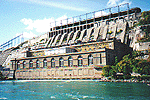
Sir Adam Beck Generating Station #1
On New Years day 1917, voters approved the construction of the Queenston-Chippawa power project. Construction began in May and continued for the next four and a half years.
The digging of the hydro canal was much harder than initially thought. It was 12.5 miles (20 kms) long and rivaled the building of the Panama Canal. The power canal had to flow downhill the entire distance but part of the route from Chippawa to Queenston was uphill instead.
From the Niagara River where the Welland River meets, 4 miles (6 kms) of the Welland River had to be widened and deepened to reverse the natural direction of the water flow. Originally the water of the Welland River flowed eastward and flowed into the Niagara River. The river flow was reversed so that waters from the Niagara River flowed westward into the Welland River.
The Welland River section is approximately 300 feet (91.4 m) wide. Excluding the river, the hydro canal is 8.5 miles (14 kms) long. The 1� mile (2.4 kms) long earth section is 307 feet (93.5m) wide. The 7.25 mile (11.7km) long rock section is 45 feet (13.7m) wide. The average depth of the water is 34 - 40 feet (10.4m-12m) deep. The maximum depth of earth and rock cut was 143 feet (43.5m). The water flows at a rate 22,000 cubic feet per second (62.3 cubic meters per second). The canal ends at the giant forebay built at the entrance to the Sir Adam Beck #1 power station. The concrete trapezoidal section of the canal over the ancient buried gorge is 307 feet (93.6 m) wide at the surface and 185 feet wide (56.4 m) at the base.
The flow to the canal has been drained and/or drastically reduced for examination and remedial work in 1955, 1964 and 1982.
The Hydro Canal supplies water to Sir Adam Beck #1 Power Station
The Powerhouse was 590 feet (180m) in length, 135 feet wide (41m) and 18 stories in height. It consisted of ten generators and cost $76 million dollars to build.
Construction work started in May 1917 and water was turned into the canal on 24 December 1921. The project was originally known as the Queenston - Chippawa Power Station.
Generators: Units #1, #2 and # 4 went in service on 26 January 1922.
Generators: Unit #5 went into service in 1923.
Generators: Units #3, #6 and # 7 went into service in 1924.
Generators: Units # 8 and #9 went into service on December 5th 1925.
Generators: Unit #10 went into service in July of 1930.
The first generator was tested on Christmas day 1921 and went into full operation one month later in January 1922.
The turbo-generator units turn at 187 � rpm and have short vertical shafts. The turbines are single-runner, Francis type. The alternators are 12,000 volts, three phase; all were 25-cycle originally but units 9 and 10 were changed to 60-cycle later. Each unit has its own set of transformers and its own transmission circuit. Each generator unit weighs approximately 1044 tons. Each transformer weighs 100 tons.
There are ten concrete encased, steel penstocks. Each is 383 feet long and 16 feet in diameter. At the base of each penstock is a valve that regulates the water flow before entering the turbine. At the entrance to each penstock, there are three openings. Each opening has a set of service gates and trash racks that protect the turbines below from being damaged or clogged by large objects.
The ten generators that produce 500,000 kVA of electricity with a net head of 300 feet.
Apparent Power (kVA): A term used to describe the product of current and voltage, expressed in kilovolt amperes (KVA). The apparent power in KVA multiplied by the power factor (PF) is the real power in kilowatts (KW)
The ten generators of Sir Adam Beck #1 Power Station produces 403,900 kilowatts of electricity.
Ten thousand men worked for an average weekly pay of $35.
In 1920, the eighteen year fight between Sir Adam Beck and the private power syndicate ended when the Ontario Hydro Power Commission purchased the Toronto Power Plant and the Toronto Electric Light Company.
In 1925, Sir Adam Beck died of pernicious anemia. Beck had given Ontario the cheapest publicly owned hydro-electric power system in the world.
On August 15th 1950, the twenty-fifth anniversary of his death, the Queenston Power Plant was renamed Sir Adam Beck - Niagara Generating Station #1. Work was about to begin on the construction of plant #2 which would be three times as large as plant #1.
All the generating units at Beck #1 have been upgraded with the past decade. The last of the two 25 cycle generators have been mothballed pending being retro-fitted with 60 Hz generators. The G7 unit at Sir Adam Beck No.1 was an 85-year-old 25-cycle generator, installed in 1924 after the first Beck station opened in 1922. It used to produce an older type of electricity, which was used by only a few industrial customers. After Ontario converted to 60-cycle power, demand gradually dropped of for 25-cycle power and it was phased out in 2009.
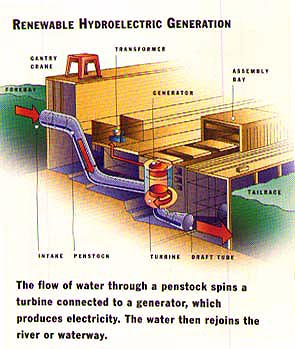
A Cross Section Diagram of Sir Adam Beck Hydro Generating Station courtesy of Ontario Hydro
Sir Adam Beck Niagara Generating Station #2

Sir Adam Beck Generating Station #2
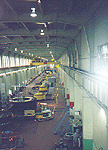
A view of the inside of Sir Adam Beck Generating Station #2
Sir Adam Beck Power Station #2 was located just south of Beck Power Station #1. It would require three times as much water.. It consists of 16 generators. The generators are totally enclosed and water cooled; each has non-continuous amortisseur windings and is equipped with directly connected exciters and with static voltage regulators. Each unit is running at 60 cycle is capable of producing 80,000 kVA for a total capacity of 130,000 kVA.
Apparent Power (kVA): A term used to describe the product of current and voltage, expressed in kilovolt amperes (kVA). The apparent power in kVA multiplied by the power factor (PF) is the real power in kilowatts (KW)
Generators: Units 11, 12, 13, 14, 15, 16 and 17 went into service in 1954.
Generators: Units 18, 19, 20, 21 and 22 went into service in 1955.
Generators: Units 23 and 24 went into service in 1957.
Generators: Units 25 and 26 went into service in 1958.
Sir Adam Beck #2 Power Station is 875 feet (266.7 m) long. It has 16 concrete encased steel penstocks. Each is 492 feet (150m) long and 16 feet (5m) in diameter with a vertical drop of 292 feet (89m). At the head of each penstock are trash racks and two motor operated steel gates. In an emergency, these gates can be closed by remote. These gates serve to control the flow of water into the penstocks since no valves are installed at the base of the penstocks like they are at Beck #1.
Water to the Sir Adam Beck Power Station #2 is provided by twin intake tunnels. The intakes are located in the Niagara River at Chippawa.
Water was diverted from the upper Niagara River at Chippawa by intakes that are square tubes and are oriented parallel to the Niagara River. Similar in shape to a triangle, they vary in area from 20 feet (6m) square at the upriver end to 45 feet (14m) square at the downriver end.
Each 650 feet (200m) long tube has 30 intake ports. Piers separating these ports channel intake flow along the tubes.
The 45 feet (13.7m) square sections leading each of the gathering tubes turn shoreward 30 degrees, at which point they leads to the control gates.
The control gates; one for each tunnel are 58 feet (18m) high and 45 feet (14m) wide. Beyond the gates, the square tubes change from square to circular.
Covered conduits 370 feet (113m) long and 45 feet (14m)) in diameter lead to the tunnels which are of the same diameter. Each tunnel was located 250 feet (76m) apart.
The tunnels slope at a steep downward degree angle until they are approximately 330 feet (100 m) below ground level at access shaft No.5. The tunnels gently rise for nearly 5 miles (8 kms) to just south of Whirlpool Road where the tunnels surface at a 30� angle and terminate into an open cut canal.
The tunnels would have been too hazardous and expensive to continue as they passed through the glacial silt of the buried St. David's Gorge. The water is channeled through a 2,200 feet long (670.5m) concrete lined trapezoidal section of the canal as it crossed the buried gorge.
An open cut channeled water to the Sir Adam Beck Power Station #2 forebay the remaining 2.25 miles (3.6 kms). The Average width of this canal is 200 feet wide (60m). Water flows at a rate of 7-8 feet per second (2.1 m/s) and has a depth of 28 feet (8.5m).
As the water enters the forebay the flow of the water is reduced to 3 feet per second (1m/s).
Excavation for both tunnels was carried out from five shafts located between them. The tunnels have a finished diameter of 45 feet (13.7m). The concrete tunnel lining is about 3 feet thick (1m).
The contractors for the tunnel were Rayner-Atlas Limited and Perini-Walsh, and Pitts & Associates. The estimated cost at the time of construction in 1951 was about $157 million.
In 1956, Ontario Hydro competed construction of the 750 acre above ground water reservoir. The rock and debris quarried from the hydro canal cut was used to build the walls of this giant reservoir which measured approximately 2 miles (3.2kms) long and � mile (0.8kms) wide. The walls measured 150 (45.7m) to 200 (60m) feet wide at the base. At the western end of the reservoir, the walls were 60 to 80 feet in height. At the eastern end of the reservoir the walls were 40 to 50 feet in height. The inner base and inside of the walls were compacted with a special clay so that when the reservoir was filled the clay sealed the walls preventing any significant leakage.
Water is pumped into the reservoir at night by use of 6 - 30 megawatt pumping/generating units. The six electric pumps which did this also doubled as generators. During the day, when water flow is increase to the Falls, water is released from the reservoir to compensate for this. As the water is released from the reservoir the pumps turned generators produce electricity as well. Each unit having an output of 47,000 horsepower at a maximum discharge of 5,600 cubic feet per second.
To ensure year round water supply would not be choked off by ice, Ontario Hydro walled off 14 acres of the upper Niagara River at the water intakes and extended two 500 foot (152m) long tubes out into the water. Each tube is capable of supplying water to the tunnels at a rate of 7,500,000 gallons per minute. Combined, the two tunnels could supply 15 million gallons of water per minute to the Sir Adam Beck #2 Generating Station.
By March 1954, The Sir Adam Beck - Niagara Generating Station began hydro-electric power generation. When opened, it was the worlds largest but only for a short time.
The sixteen generators are housed in a building almost twice as long as plant #1 and has a capacity of 1,223,600 kilowatts.
Each generator is 50 feet (15m) in height and rotates at 150 revolutions per minute. The revolving parts weigh 500 tons.
REMEMBERING THE WORKMEN - DIED ON PROJECT
The following is a preliminary incomplete list of those killed on the Beck 2 project. The dates given are those dates that their deaths were reported, so for the most part the day before would have been the actual date of death. Twenty-one (21) workmen died during the construction of this power project.
November 17th 1951 – Edward Honke age 32 – shaft 2
February 21st 1952 – Robert S. Thomas age 25
April 12th 1952 – Corky Hill – hit in head by falling rock
June 6th 1952 – Armand Dube age 31 – at intake
June 28th 1952 – Giuseppe Diriso age 43 – killed by truck on Stanley Avenue
November 4th 1952 – Antonio Critelli age 43 – killed by truck in tunnel
January 28th 1953 – Ernest Juteau age 20 – 10th fatal on project
February 14th 1953 – George Chornley age 22 – in section 3 – 11th fatal
February 27th 1953 – Peter Volkmann
March 28th 1953 – Giuseppi Biamonte age 25 – tunnel 2 section 3 – 13th fatal
April 14th 1953 – Gilbert Dubroy age 20 – section 5 tunnel 1 near portal inlet – run over by Jumbo machine – 14th fatal
May 11th 1953 – Soloman Morin age 46 – hit on head by rocks between sections 1 & 2 – 15th fatal
missing at moment – 16th fatal
July 21st 1953 – James St, Onge age 39 – run over by truck at shaft 1 – 17th fatal
July 30th 1953 – Albert McLeod age 40 – lead miner, struck by wire pulley shaft 5 – 18th fatal
November 2nd 1953 – Alden Gilmore Deer age 28 – shaft 4 had fracture resulting in embolism – 19th fatal
April 22nd 1955 – Albert Bandeen age 38 – pierced in back by falling piece of steel penstock11
I am still missing 5 workmen from the list. I will try to fill in the missing names as time permits.
The dates of those killed are sometimes disjointed. In the case of both Beck #1 & Beck #2 both plant sizes were expanded as an afterthought thus the time lapses. On October 26 1957 Ontario Hydro met with their American counterparts – New York State Power Authority. During the meeting Ontario Hydro listed the dead workmen from the project at 16. It may be they may have been counting from the water up dates for both tunnels only and not the continued construction on the power house.
At the time of the Inauguration of the Sir Adam Beck Power Generating Station in August 1954, it was mentioned that “there have been 21 men killed in the 7,600-member work force….18 of them were employed by the construction companies and 3 by Hydro.”
Robert Moses Niagara Generating Station

A view of the Robert Moses Hydro Generating Station
On June 7th 1956 at 5:00 p.m., the Schoellkopf Power Station sustained a catastrophic collapse which destroyed two-thirds (2/3) of the plant. Six generators capable of producing 322,500 horsepower had been demolished. Employee, Richard Draper, age 39 of Lewiston was killed. Damage was estimated at $100 million dollars. The most devastating was the sudden loss of 400,000 kilowatts of power from the power grid.
To replace the Schoellkopf Power Station, the New York State Power Authority committed itself to the building of a new power station along with a giant reservoir further downstream near Lewiston. This power plant was estimated to cost $800 million dollars and would take three years to build.
Robert Moses was the head of the New York Power Authority and would oversee the building of this new plant. Moses' first step was to establish that the building and operation of the Niagara Power Project would come under the ownership of the New York State Power Authority.

A view of the control room of the Robert Moses Hydro Generating Station
In addition to building this power station, the New York State Power Authority was to build an eighteen (18) mile (29 kms) parkway including an interchange to the Queenston - Lewiston Bridge, as well as the development of the Whirlpool State Park and Devil's Hole State Park along this parkway.
In August of 1957, the U.S. Congress approved the building of the Niagara Power Project with the capacity to produce 2.4 million kilowatts.
Land for the reservoir was expropriated from the Tuscarora Indians. The New York State Power Authority wanted to expropriate 1,350 acres of the 6,300 acre Indian Reservation. The Tuscarora Indians fought this expropriation to the United States Supreme Court.
On March 7th 1960, the New York Power Authority won a Supreme Court decision for the right to expropriate 550 acres of the Tuscarora Reservation at a cost of $1,500 per acre.
Construction began on March 18th 1957. During construction twelve million cubic yards of rock was excavated. The main structure of the power station was 389 feet (118m) high, 580 feet (177m) wide and 1,840 feet (561m) long.
During the construction, twenty men died in construction related accidents. Two giant 24 - ton Euclid trucks each valued at $47,000 fell into the river below.
The Niagara Power Project was completed fourteen days earlier than the three year deadline for the completion of this project.
The Niagara Power Project was renamed the Robert Moses Power Generating Station after its builder, Robert Moses.
The Robert Moses Niagara Hydro-Electric Power Station of the New York State Power Authority was opened in January 28th 1961. It is the largest of the Niagara generating stations.
Water for this power plant is drawn from the Niagara River 2.5 miles above the Falls along the American shoreline. Six hundred thousand (600,000) gallons of water per second is drawn through two - 700 foot (213m) long intakes located below water level. Twin buried conduits 46 feet (14m) wide and 66 feet (20m) high lead from the intake and run 4 miles (6 kms) to the forebay. Each conduit has a 400 ton vertical lift gate and each is housed in a structure 49 feet (15m) wide and 66 feet (20m) high.
From the forebay water enters the turbines through 460 foot (140m) long penstocks which are 28.5 feet (8m) in diameter. Water is discharged directly into the Niagara River after passing through the turbines.
There are thirteen turbines rated at 200,000 horsepower each. Capacity of power output is rated at 2,300 megawatts. A 1,900 acre water reservoir is utilized to feed the turbines during the daytime holds 22 billion gallons of water.
Robert Moses retired from the New York State Power Authority in 1962. He was 73 years old.
Niagara River Water Diversion Treaty
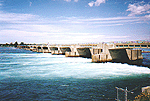
A view of the International Hydro Water Control Dam
In 1909, the Boundary Waters Treaty, a new USA-Canada International Treaty, established the amount of water that could be diverted from the Falls.
This treaty limited the amount of water that could be diverted from above the Falls for power generation to 56,000 cubic feet per second. The USA was allowed to divert 20,000 cubic feet of water per second and the Canadians were allowed to divert 36,000 cubic feet per second.
The unequal amount of water allowed to be diverted, by the USA and Canada was in consideration for USA water diversion through the Chicago drainage canal from Lake Michigan and the Canadian export of power to New York.
By 1919, the USA was using all of the water it was allowed to divert. In 1927, Canada reached the maximum allotment of water diversion.
When the maximum water diversion was reached in accordance to this treaty, it became necessary to record the amount of water being used on a daily basis by the different power companies to ensure the terms of this treaty were being complied with.
The job of ensuring the terms of this treaty were complied with rested with the International Niagara Board of Control. This board consisted of two members: one American and one Canadian.
During low water conditions, the Horseshoe Falls and the American Falls had an insufficient flow to cover their entire crest lines yet there was a growing need for more power.
To study the issue, the International Board of Control was increased to four members. The final report of the Board of Control was completed in June 1928.
The Board recommended remedial work in the form of submerged weirs to take the water from the deep water near the center of the Horseshoe to the outer banks to ensure the crest lines were covered.
The American Falls had a water flow of only 7,000 cubic feet per second which was so little that the underlying rocks were visible. This condition disappeared when the water flow was increased to 9,000 cubic feet of water per second.
To ensure a minimum flow over the American Falls, the Board proposed to construct a weir in the still water pool above the upper rapids in an area known as the Chippawa - Grass Island Pool. The Board also authorized an increase in water diversion for power generation.
In 1922, the International Board of Control suggested building an artificial island upstream from the Falls in order to divert the waters.
On June 2nd 1929, both Governments signed a conventions agreeing to the Board of Control recommendations. This convention was ratified by Canada in 1929 and by the USA in 1931.
In 1941, The Great Lakes - St. Lawrence Basin Agreement was signed by Government representatives but it was never ratified. In this agreement, the remedial work was approved as was an immediate additional 5,000 cubic feet of water per second diversion by each country for power generation.
On October 27th 1941, as an emergency measure during World War II, the governments of USA and Canada authorized the maximum diversion of waters from the Niagara River for power generation. The Americans were authorized to divert 32,500 cubic feet of water per second and the Canadians were authorized to divert 50,000 cubic feet of water per second.
Both governments recognized the need for recommended remedial work and agreed to share the costs.
On January 23rd 1942, the Great Lakes - St. Lawrence Basin Committee submitted an estimate for the remedial work for Niagara Falls at $803,000.
Construction of the submerged weir began in March 1942. When completed, the weir was 1,455 feet (443m) long, extending from within 300 feet (91m) of the Canadian shoreline towards the shoal upstream from Goat Island. The width of this rock filled weir was approximately 40 feet (12m) and ranged in height according to the river from 2 - 10 feet (0.6-3m) in depth.
To place the stone in the river, a cable way was constructed. Two 155 foot (47m) tall steel towers were built: one on the Canadian shoreline and the other on a man made island just inside the American boundary.
This island is known as "Tower Island" and it still exists today as a terminus for the Hydro Control Dam. To build this island, the US Army Corps of Engineers built a 2,200 foot causeway from the eastern end of Goat Island.
Government negotiations throughout 1949 resulted in the American and Canadian Governments signing the Niagara Water Diversion Treaty in February 1950.
Canada was allowed to divert 56,500 cubic feet of water per second and the USA was allowed to divert 32,500 cubic feet of water per second. Most importantly, this treaty declared that all the water in the river could be used for hydro generation providing that sufficient water was allowed to flow over the Falls to maintain its beauty and scenic effect.
In October 1950, the International Joint Committee were authorized to study and report on remedial work required for the preservation of the Falls. Their recommendations were approved July 22nd 1953.
During the next four years, a 1,550 long (472m) Hydro Control Dam was built 250 feet (76m) downstream from the submerged weir. The dam extended from the Canadian shoreline and was needed to regulate the water level in the Chippawa - Grass Island Pool. This dam has since been extended.
The American and Canadian flanks of the Horseshoe Falls were reconstructed to produce and unbroken flow of water over the entire crest line.
The path for construction of this second generating station was cleared with the ratification of the Niagara Diversion Treaty between Canada and the USA.
This treaty spelled out for the first time how much water could be diverted from the river for hydro generation. It specified that a minimum 100,000 cubic feet of water per second would flow over the Falls during the day, while at night this flow would be reduced to a minimum 50,000 cubic feet per second.
The Great East Coast Blackout
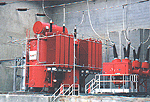
A view of one of the transformers at the Robert Moses Generating Station
The Great North-East Blackout began when the northeastern region of Canada and the United States was plunged into blackness at 5:16 p.m. on November 9th 1965. It was the largest single power failure in history that plunged thirty million people (one-sixth of the population of the North American) in eight American states and the eastern portion of Ontario into total darkness.
Power was subsequently restored within three hours in most parts of the province. New York City was without power for as long as 13 hours.
Electrical power failure began when a single transmission line from the Sir Adam Beck # 2 Generating Station tripped into the open (shutdown) position.
The malfunction of this backup relay was on one of the six lines linking the Sir Adam Beck No. 2 Generating Station with the rest of the eastern power grid. Within 2.5 seconds, the remaining five transmission lines became overloaded and tripped (shutdown) open, isolating the 1,800 megawatts of power being generated at the power station.
The generators at Sir Adam Beck became unstable and began automatic shut down. A sudden surge of power tripped the circuit breaker and the backup relay failed. This power surge was the catalyst for what occurred.
The overflow of power leaped to the other five lines, the relays of which overloaded and tripped their circuit breakers. The process continued along lines in New York State until the entire grid of thirty-one interconnected power utilities had broken down.
The northeast power system became unstable and separated into isolated power systems within 4 seconds. Outages occurred throughout New York, Ontario, most of New England, and parts of New Jersey and Pennsylvania.
Quick Facts
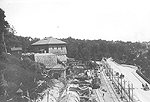
An historic photograph of conduit construction for the Ontario Power Generation Station
courtesy of the Niagara Falls (Ontario) Public Library
The Niagara generating stations supply one quarter of all power used in New York State and Ontario.
Ontario Hydro operates two (2) Hydro Generating Stations in Niagara Falls. Sir Adam Beck Plant #1 & Plant #2 are located along the Niagara Parkway between the Whirlpool and Queenston, Ontario. A third station, the Ontario Hydro Generating Plant which is located just north of the base of the Horseshoe Falls was retired in 1999.
The Robert Moses Hydro Electric Plant is located in Niagara County of Western New York State between Niagara Falls, New York and Lewiston, New York.
The Sir Adam Beck Generating Stations and the Robert Moses Generating Station are build directly opposite each other. In certain circumstances one plant may sell hydro electric power to each other. Both Generating Stations are joined to each others electrical grid system by high voltage transmission lines.
The Sir Adam Beck Generating Station Plant #2 and the Robert Moses Generating Station have a small tramway that they can use to traverse from one plant to the other by crossing the Niagara River Gorge. It is primary used to take measurement of the water flow to ensure treaty compliance.
Between the base of the Horseshoe Falls and the Whirlpool the water elevation drops approximately 71 feet (22m).
From November to April, the water in the river below the Falls does not fluctuate substantially because the water flow remains constant at minimum 50,000 cubic feet per second. During this period water diversion for hydro electric generation is at its maximum. The water level in the lower river is approximately 12 feet (3.6m) lower than during the peak flow period from April to November. This is the reason why the Maid of Mist tour boats is taken out of the water prior to October 31st each year.
From April to November the water level below the Falls rises an average of 3 feet (1m) each morning between 8:00 a.m. and 9:00 a.m.. Similarly, the water drops an average of 3 (1m) feet each night between 8:00 p.m. and 9:00 p.m.
The normal flow of water volume flowing over the Horseshoe Falls is approximately 100,000 cubic feet per second. The peak flow over the Horseshoe Falls recorded by Ontario Hydro has been 225,000 cubic feet per second.
At night, when Hydro Control Dam gates are lifted for diversion of Niagara River water into the hydro tunnels, the flow over the Horseshoe Falls drops to a minimum 50,000 cubic feet of water per second.
Between November 1st and April 1st each year the water flow rate is reduced to 50,000 cubic feet per second for 24 hours per day. This is done to aid the power companies when the numbers of tourists are at a minimum.
By International Agreement, the Canadians draw 56,500 cubic feet of water per second and the Americans draw 32,500 cubic feet of water per second.
The Sir Adam Beck Generating Stations and the Robert Moses Generating Station together form the largest generators of hydro electric power in North America.
Flow rates of water are monitored by Ontario Hydro from sensing devices on both the Rainbow International Bridge and the Whirlpool International Bridge. Flow rates for particular times and dates can be determined.
The Ontario Hydro water intake gates for water diversion are located 2.6 km (1.6 miles) upstream from the Horseshoe Falls. They are located just south of the Hydro Control Dam and are in excess of 90 feet in height.
The International Control Dam operated by Ontario Hydro and the New York State Power Authority is located 2.6 km (1.6 miles) upstream from the Falls.
This concrete and steel dam controls the water rate of flow over the Falls. Approximately eighteen (18) gates are raised or lowered in order to increase the water flow over the Falls and to hold back the water flow for diversion into the Hydro Tunnels of Ontario Hydro and the New York State Power Authority. The dam extends 2,200 feet (670m) to the International boundary.
Ontario Hydro has two water tunnels which traverse the entire City of Niagara Falls from the Village of Chippawa in the South to the Sir Adam Beck Hydro Electric Generating Stations in the North. Each tunnel is approximately 5.5 miles (9 km) long and is forty-five (45) feet (14m) in diameter and are buried up to 330 feet (100m) below ground level. The tunnels carry 54 million liters of water per minute to the generating stations. In addition Ontario Hydro has an 8.5 mile (13.6 km) open canal which traverses the entire City of Niagara Falls which feeds from the Welland River in the South-West section to the Generating Stations.
Ontario Hydro has a 750 acre water reservoir above the Sir Adam Beck plants. At night , water is pumped into this reservoir which acts as a backup system. During the day when the flow of water is directed to the Falls, Ontario Hydro draws water from the reservoir to fill the water gap in order that the generators run at optimum capacity.
Sir Adam Beck Generating Stations -Map of Hydro Canal & Water Intake Tunnels
courtesy of Ontario Power Generation
The Robert Moses Hydro Electric Generating Plant has two buried conduits (water intakes) which are located upstream of the Falls. Both conduits parallel each other and are 100 feet (30m) deep and 400 feet (121m) wide.
The now retired Ontario Power Company was located at the base of the Horseshoe Falls. It consisted of ten (10) generators - plus one spare unit each capable of producing 10,000 horsepower. The total power output capacity was 100,000 horsepower.
Diagram of Typical Hydro Electric Generating Station
courtesy of Ontario Power Generation
In 1998, Ontario Hydro announced a third tunnel would be built under the City of Niagara Falls to supplement the existing twin tunnels. At the current time, Ontario Hydro is only diverting approximately 80% of the water that it is allowed to divert for hydro generation. Negotiations of a new Niagara River Water Diversion International Treaty begin in the year 2000.
In 1999, Ontario Hydro underwent a major restructuring. The company was divided into two sections: The Ontario Power Generation Company and the Ontario Power Distribution Company.
As a result of these changes to Ontario Hydro as well as Government of Ontario power de-regulation beginning in the year 2000, the company has announced the indefinite postponement of any tunnel construction.
At the current time both New York State Power Authority - Niagara Project and Sir Adam Beck Power Group continue to refit generators with plans to increase efficiency and power generation capacity. Ontario Power Generation has reached its maximum diversion capacity. It is likely that Ontario Power Generation will construct a third tunnel to increase their capacity to divert additional water when supplies in the Niagara River are more plentiful. On occasion, when the river levels are high, excess water is now allowed to flow over the Falls because of this lack of diversion capacity.
Niagara Tunnel Project
Ice Breakers
| NIAGARA FALLS THUNDER ALLEY NAVIGATOR | ||
|---|---|---|
| INFORMATION INDEX | HISTORICAL ARCHIVE | PICTURES & SLIDESHOWS |
| SITE MAP |
Date last updated:January 26, 2018
The following locations and facts about them are but a few of many famous sites & attractions to be found in Niagara Falls. The best of it is FREE to see...so think of Niagara Falls when planning your next vacation. If you have questions of a current or historical nature about the Niagara Falls area or suggestions feel free to e-mail Rick at
THANK YOU FOR VISITING
NIAGARA FALLS
HISTORY OF POWER
page

